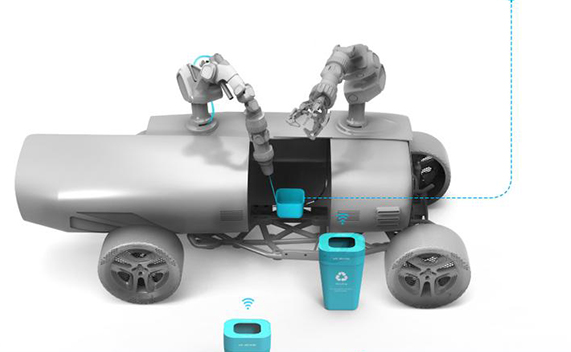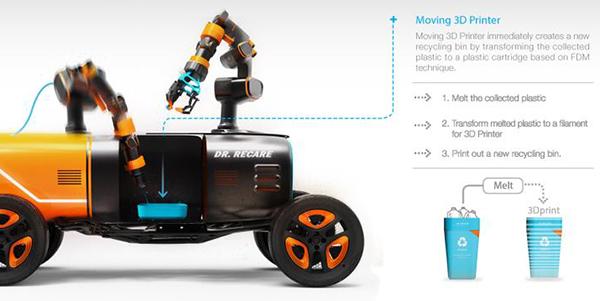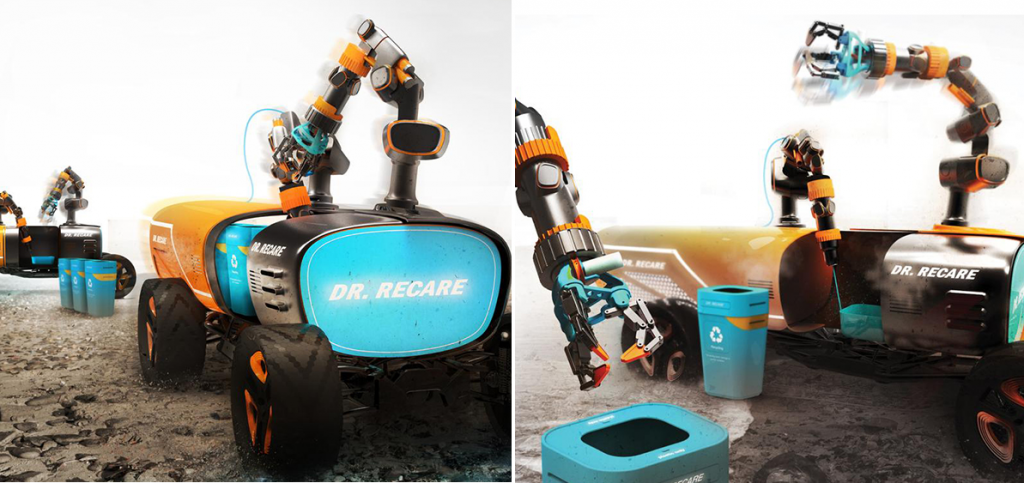Introducing Dr. Recare — Spring Break Beach Clean-Up Work Covered by 3D Printing Robots?
 I frequent the famous white-sanded and turquoise-watered beaches of the Florida panhandle. And, as much as we say it over and over, it IS infuriating to see trash on the ground and in the water. This is especially a problem during Spring Break all over the United States. Where I walk, I could spend the hour just picking up plastic bottles and aluminum beer cans–but I gave that up because they keep reappearing. Well, if one designer has her way there may be a new beach cleaning ‘Doctor’ in town. Mingyu Jeong designed a concept for what could best be described as an automated robotic beach cleaner with a built in 3D printer. Called Dr. Recare, it could change the way we deal with litter. Could this concept become a reality?
I frequent the famous white-sanded and turquoise-watered beaches of the Florida panhandle. And, as much as we say it over and over, it IS infuriating to see trash on the ground and in the water. This is especially a problem during Spring Break all over the United States. Where I walk, I could spend the hour just picking up plastic bottles and aluminum beer cans–but I gave that up because they keep reappearing. Well, if one designer has her way there may be a new beach cleaning ‘Doctor’ in town. Mingyu Jeong designed a concept for what could best be described as an automated robotic beach cleaner with a built in 3D printer. Called Dr. Recare, it could change the way we deal with litter. Could this concept become a reality?
Dr. Recare is a 3D printing robotic “doctor” designed with the mission of a superhero (or superhuman): it can supposedly easily, efficiently–and triumphantly once and for all?–clean up our beaches while we still enjoy the sand and waves. This machine works in a way that I would not have easily imagined would be efficient, and I have questions about cost. Dr. Recare cleans sand  itself by acting as a plastics recycler — on site. It extracts and heats up plastic garbage, then turns the plastic into 3D printer filament which it uses to 3D print recycling bins. You can view the whole process here.
itself by acting as a plastics recycler — on site. It extracts and heats up plastic garbage, then turns the plastic into 3D printer filament which it uses to 3D print recycling bins. You can view the whole process here.
Part of the reason we are in the position we are in regarding beach pollution is there has been massive oil spills and no efforts to support the clean-up from the front line plastics production side of the issue. (We can simply stop producing more trash.) Oil companies spill with little repercussions, humans litter, and beaches get junked: but what’s the actual expense, and is on-site recycling via 3D printing with the trash a solution?
For example, on Panama City Beach, Florida you see tons of trash on the beaches at Spring Break. This, and participants’ behavior, has caused locals to call for canceling Spring Break altogether — which is impossible to do. Now that we have located the problem of making clean up attractive with Dr. Recare’s help: maybe Spring Break beaches could showcase this as an educational tool, or a student volunteer opportunity, if it’s ever actually manufactured.
 You can see by the size of the above crowd, on site stations could be established and highly functional. People are still needed to run these machines, ultimately, but they showcase 3D printing technology and the significance of the actual behavior of generating so much waste by recycling it in front of users’ eyes on location. I see Dr. Recares as being one way to approach recycling plastic into something useful–but we still want to stop generating plastic bins at some point too right? The educational aspect of this design is its best feature — and I would love to go see them out on site at our next Spring Break!
You can see by the size of the above crowd, on site stations could be established and highly functional. People are still needed to run these machines, ultimately, but they showcase 3D printing technology and the significance of the actual behavior of generating so much waste by recycling it in front of users’ eyes on location. I see Dr. Recares as being one way to approach recycling plastic into something useful–but we still want to stop generating plastic bins at some point too right? The educational aspect of this design is its best feature — and I would love to go see them out on site at our next Spring Break!
Highly trafficked beach locations also feature events like Pirates’ Day and many concerts. These are the days that public education is most possible for things like 3D printing. When I look at 3D printing projects, I want to see a holistic design effort that also views the environmental costs of actually making the machine itself. If it can be integrated into holistic public education and practical beach clean-up efforts, without being touted as the “answer”: I am all for it. Let’s get started yesterday! Let’s hear your thoughts on this concept. Discuss in the Dr. Recare forum thread on 3DPB.com.
Subscribe to Our Email Newsletter
Stay up-to-date on all the latest news from the 3D printing industry and receive information and offers from third party vendors.
Print Services
You May Also Like
APES Unveils Vision for 3D Printed Electronics Factory
Advanced Printed Electronic Solutions (APES) is a systems integrator, 3D printing service, and consultancy partner for additively manufactured electronics. 3D printed electronics machines have been around, but a truly scalable,...
Parallax Volumetric Additive Manufacturing Debuts at RAPID via Manifest Technologies
Manifest Technologies is showcasing its take on volumetric additive manufacturing at this year’s RAPID+TCT event, this week in Detroit, Michigan. Manifest, formerly known as Vitro3D, spun out of the University...
Moving Beyond the Hypothetical: the Role 3D Printing Should Play in US Reshoring
Barely two months into President Trump’s second term, it’s already cliché to point out that chaos is the only constant thread running through all of the new administration’s policies. (Indeed,...
HBD’s New Plant Adds to China’s 3D Printing Growth
As China strengthens its position in the global 3D printing market, metal additive manufacturing company HBD Additive Manufacturing has opened a new facility in Guangdong. The site expands HBD’s production...



























